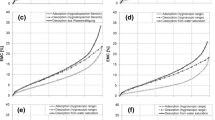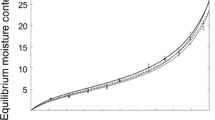Abstract
Equilibrium moisture content (EMC), net isosteric heat of sorption (NIHS), net entropy of sorption (NES) and standard free energy of Gibbs (SFEG) of Triplochiton scleroxylon (obeche) and Sterculia rhinopetala (lotofa) are modeled using Nelson’s sorption isotherm model. Experimental data are determined using a dynamic vapor sorption apparatus. Air relative humidity is ranged from 0 to 90% and two air temperatures (20 °C and 40 °C) are used. Experimental data of EMCs obtained from adsorption and desorption for the mentioned woods were compared with the predicted results using Nelson’s sorption model by the application of the same operating conditions (i.e. temperatures and relative humidity conditions). The results showed that the predicted ones were in good agreement with the experimental data, when the relative humidity varied from 1.2 to 90%. Both adsorption and desorption phase presented a mean relative errors value inferior to 6.3%. The parameters that define the sorption isotherm varied with the wood type and the sorption mode. Thus, Nelson’s sorption isotherm model is a useful tool that can be used for prediction of the moisture change in wood under different environmental conditions and for predicting indirectly the thermodynamic parameters such as NIHS, NES and SFEG. In adsorption and desorption mode, the NIHS are estimated using Clausius-Clapeyron’s equation. The desorption values were higher than the adsorption ones. NIHS versus EMC varied exponentially and the parameters of the function were presented variable with the sorption mode and the wood type. The total energy that we needed to extract and evaporate all bounded water is 12,398.6 J/mol for obeche and 11,627.7J/mol for lotofa. The total energy that we needed to condense and fix all bounded water taken from the state vapour is 11,829.34 J/mol for obeche and 11,379.39 J/mol for lotofa. Water molecules are more mobile during desorption than adsorption in the case of obeche. In the case of lotofa, these molecules are more mobile during adsorption. SFEG is higher in desorption than adsorption and it is influenced by species and less by the temperature. When the temperature increased, the SFEG increased as well. At low values of EMC, NIHS and SFEG are higher and decreased with the increase of EMC until reaching the fibre saturation point.













Similar content being viewed by others
References
Gérard J, Kouassi AE, Daigremont C, Détienne P, Fouquet D, Vernay M (1998) Synthèse sur les caractéristiques technologiques de référence des principaux bois commerciaux africains. CNRA Abidjan, CIRAD-Forêt. http://forafri.cirad.fr/ressources/forafri/26.pdf. Accessed 19 December 2018
Benoît Y (2008) Le guide des essences de bois. FCBA, Eyrolles. http://wood.woodtools.nov.ru/books/guide_de_bois/guide_de_bois.pdf. Accessed 19 December 2018
CIRAD (2012) TROPIX 7. 1998-2011. https://tropix.cirad.fr/FichiersComplementaires/FR/Afrique/LOTOFA.pdf. Accessed 19 December 2018
Simo-Tagne M (2014) Experimental characterization of the influence of water content on the density and shrinkage of tropical woods coming from Cameroon and deduction of their fiber saturation points. International Journal of Science and Research (IJSR). 3(6): 910-915. https://www.ijsr.net/archive/v3i6/MDIwMTQ1NQ==.pdf. Accessed 21 December 2018
Gabas AL, Menegalli FC, Telis-Romeno J (2000) Water sorption enthalpy entropy compensation based on isotherms of plum skin and pulp. J Food Sci 65(4):680–684. https://doi.org/10.1111/j.1365-2621.2000.tb16072.x
Kaymak-Ertekin F, Gedik A (2004) Sorption isotherms and isosteric heat of sorption for grapes, apricots, apples and potatoes. Lebensm-Wiss u-Technol 37:429–438. https://doi.org/10.1016/j.lwt.2003.10.012
Ciro H, Osorio JA, Cortes EA (2008) Determination of the isosteric heat to plantain pulp (musa paradisiaca) by sorption isotherms. Dyna, Año 75, Nro. 156, pp. 127-134. Medellín, Noviembre de 2008. ISSN 0012-7353. http://www.scielo.org.co/pdf/dyna/v75n156/a12v75n156.pdf. Accessed 21 December 2018
Van Den Berg C, Bruin S (1981) Water activity and its estimation in food systems: Theoretical aspects. In: Rockland LB, Stewart GE (eds) Water activity; influence on food quality. Academic Press, New York, pp 45–58
Esteban LG, De-Palacios P, Fernández FG, Guindeo A (2008) Thermodynamic characteristics of particleboard using sorption isotherms. Wood Research 53(2):45–56
McMinn WAM, Magee TRA (2003) Thermodynamic properties of moisture sorption of potato. J Food Eng 60:157–165. https://doi.org/10.1016/S0260-8774(03)00036-0
Moreira M, Chenlo F, Vázquez MJ, Cameán P (2005) Sorption isotherms of turnip top leaves and stems in the temperature range from 298 to 328K. J Food Eng 71:193–199. https://doi.org/10.1016/j.jfoodeng.2004.10.033
Tunç S, Duman O (2007) Thermodynamic properties and moisture adsorption isotherms of cottonseed protein isolate and different forms of cottonseed samples. J Food Eng 81:133–143. https://doi.org/10.1016/j.jfoodeng.2006.10.015
Bonoma B, Simo-Tagne M, Monkam L (2010) Influence of the temperature and water content on the density and porosity of tropical woods: ayous, baobab, sapelli, lotofa and padouk. Phys Chem News 51:79–83 ISSN: 1114-3800
González-Rodrigo B, Esteban LG, De-Palacios P, García-Fernández F, Guindeo A (2013) Variation throughout the tree stem in the physical-mechanical properties of the wood of Abies alba Mill. from the Spanish Pyrenees. Madera y Bosques 19(2):87-107. http://oa.upm.es/26839/1/INVE_MEM_2013_165413.pdf. Accessed 19 December 2018
Simo-Tagne M, Bonoma B, Machebu-Siaka M (2009) Experimental and theoretical study of drying kinetic, of diffusion coefficient and density of ayous. Phys Chem News 49:65–73 ISSN: 1114-3800
Simo-Tagne M, Bonoma B, Nsouandélé JL, Njomo D, Ndjidda B (2010) Experimental and theoretical study of drying kinetic, diffusion coefficient and density of cameroonian ebony. Phys Chem News 56:85–91 ISSN: 1114-3800
Bonoma B, Simo-Tagne M (2005) A contribution to the study of the drying of ayous (Triplochiton Scleroxylon) and of ebony (diospyros ebonum). Phys Chem News 26:52–56 ISSN: 1114-3800
Fernàndez FG, Cristina Simon, Esteban LG, De Palacios P, Fernàndez-Golvin JI, Conde M (2013) Estudio comparativo del método de cámara y de sales saturadas en la obtención de los puntos de humedad de equilibrio higroscópico de la limba (Terminalia superba Engl. & Diels.). 6° Congres 0 forestàl Espànol, 2-10
Fernàndez FG, Esteban LG, De Palacios P, Simon C, García-Iruela A, De La Fuente J (2014) Sorption and thermodynamic properties of Terminalia superb Engl. & Diels and Triplochiton scleroxylon K. Schum. Through the 15, 35 and 50°C sorption isotherms. Eur J Wood Prod 72:99–106. https://doi.org/10.1007/s00107-013-0752-x
Jannot Y, Kanmogne A, Talla A, Monkam L (2006) Experimental determination and modelling of water desorption isotherms of tropical woods: afzelia, ebony, iroko, moabi and obeche. Holz Roh Werkst 64:121–124. https://doi.org/10.1007/s00107-005-0051-2
Simo-Tagne M, Zoulalian A, Njomo D, Bonoma B (2011) Modelisation of desorption isotherms and estimation of the thermophysic and thermodynamic properties of tropical woods in Cameroon: the case of Ayous and Ebony woods. Revue des Energies Renouvelables (14):487–500. http://www.webreview.dz/IMG/pdf/Modelisation_of_desorption_isotherms_and_estimation_of_the.pdf. Accessed 21 December 2018
Simo-Tagne M, Zoulalian A, Rogaume Y, Rémond R, Bonoma B (2016) Modélisation des isothermes de sorption, caractérisation des propriétés thermodynamiques et détermination des humidités d’équilibre d’usage des bois tropicaux. Revue des Energies Renouvelables 19(1):79–96. https://www.cder.dz/download/Art19-1_9.pdf. Accessed 21 December 2018
Bahar B, Azzouz S, Remond R, Ouertani S, Taher-Elaieb M, Afif-El-Cafci M (2017) Moisture sorption isotherms and thermodynamic properties of Oak wood (Quercus robur and Quercus canariensis): optimization of the processing parameters. Heat Mass Transf 53(5):1541–1552. https://doi.org/10.1007/s00231-016-1916-0
Jankowska A (2018) Assessment of sorptive properties of selected tropical wood species. Drvna Industrija 69(1):35–42. https://doi.org/10.5552/drind.2018.1733
Mounaouer B, Wali A, Fourti O, Hassan A (2014) Henna wood as an adsorptive material for bentazon. Afr J Biotechnol 13(35):3597–3606. https://doi.org/10.5897/AJB2013.13000
Engelund ET, Klamer M, Venås TM (2010) Acquisition of sorption isotherms for modified woods by the use of dynamic vapour sorption instrumentation. Principles and Practice. Paper prepared for the 41st Annual Meeting, Biarritz, France, 9-13 May 2010, IRG/WP 10-40518. http://ldcluster.com/wp-content/uploads/2013/04/Forskningsartikel-fra-Thomas-Venaas-2010.pdf. Accessed 19 December 2018
Nelson RMJ (1983) A model for sorption of water vapor by cellulosic materials. Wood and Fiber Sciences. 15(1): 8-12. https://wfs.swst.org/index.php/wfs/article/viewFile/1176/1176. Accessed 21 December 2018
Liu F, Han G, Cheng W, Wu Q (2015) Sorption isotherm of southern yellow pine-high density polyethylene composites. Materials 8:368–378. https://doi.org/10.3390/ma8010368
Wu Q (1999) Application of Nelson’s Sorption isotherm to wood composites and overlays. Wood Fiber Sci. 31: 187–191. https://pdfs.semanticscholar.org/638d/42e3e5b00d572b6a99459243806d448801c1.pdf. Accessed 20 December 2018
Berry SL, Roderick ML (2005) Plant–water relations and the fibre saturation point. New Phytol 168:25–37. https://doi.org/10.1111/j.1469-8137.2005.01528.x
Kokutse AD, Brancheriau L, Chaix G (2010) Rapid prediction of shrinkage and fibre saturation point on teak (Tectona grandis) wood based on near-infrared spectroscopy. Ann For Sci 67(403):1–10. https://doi.org/10.1051/forest/2009123
Derkowski A, Mirski R, Majka J (2015) Determination of sorption isotherms of scots pine (Pinus sylvestris L.) wood strands loaded with melamine-urea-phenol-formaldehyde (MUPF) resin. Wood Research 60 (2): 201-210. http://www.centrumdp.sk/wr/201502/03.pdf. Accessed 22 December 2018
Al-Muhtaseb AH, McMinn WAM, Magee TRA (2004) Water sorption isotherms of starch powders. Part 2: Thermodynamic characteristics. J Food Eng 62(2):135–142. https://doi.org/10.1016/S0260-8774(03)00202-4
Kawongolo JB (2013) Optimization of processing technology for commercial drying of bananas (Matooke). Doktor der Agrarwissenschaften Thesis dissertation, University of Kassel
Merakeb S (2006) Modélisation des structures en bois en environnement variable. Thesis Dissertation, University of Limoges
Khalfi A, Blanchart P (1999) Desorption of water during the drying of clay minerals. Enthalpy and entropy variation. Ceram Int 25(5):409–414. https://doi.org/10.1016/S0272-8842(98)00050-9
Stamma J, Loughborough WK (1935) Therrmodynamics of the swelling of wood. J Phys Chem 39:121-132. https://pubs.acs.org/doi/abs/10.1021/j150361a009
Ngohe-Ekam PS (1992) Etude expérimentale des propriétés thermophysiques des bois tropicaux. Doctorate Thesis, Claude-Bernard University of Lyon 1
Dikrallah A (2007) Etude de la typologie des défauts des arbres sur pied, analyse de l’anisotropie acoustique et détection des altérations par tomographie : Application au Cèdre de l’Atlas (Cedrus atlantica Manetti). Thesis Dissertation, University of Mohammed V AGDAL
Ouertania S, Azzouza S, Hassinia L, Koubaa A, Belghith A (2014) Moisture sorption isotherms and thermodynamic properties of Jack pine and palm wood: Comparative study. Ind Crop Prod 56:200–210. https://doi.org/10.1016/j.indcrop.2014.03.004
Nkolo Meze’e YN, Ngamveng JN, Bardet S (2008) Effect of enthalpy–entropy compensation during sorption of water vapour in tropical woods: The case of Bubinga (Guibourtia Tessmanii J. Leonard; G. Pellegriniana J.L.). Thermochim Acta 468:1–5. https://doi.org/10.1016/j.tca.2007.11.002
Koukouch A, Idlimam A, Asbik M, Sarh B, Izrar B, Bah A, Ansari O (2015) Thermophysical characterization and mathematical modelling of convective solar drying of raw olive pomace. Energy Convers Manag 99:221–230. https://doi.org/10.1016/j.enconman.2015.04.044
Author information
Authors and Affiliations
Corresponding author
Ethics declarations
Conflict of interest statement
On behalf of all authors, the corresponding author states that there is no conflict of interest.
Additional information
Publisher’s note
Springer Nature remains neutral with regard to jurisdictional claims in published maps and institutional affiliations.
Rights and permissions
About this article
Cite this article
Simo-Tagne, M., Bennamoun, L., Léonard, A. et al. Determination and modeling of the isotherms of adsorption/desorption and thermodynamic properties of obeche and lotofa using nelson’s sorption model. Heat Mass Transfer 55, 2185–2197 (2019). https://doi.org/10.1007/s00231-019-02577-2
Received:
Accepted:
Published:
Issue Date:
DOI: https://doi.org/10.1007/s00231-019-02577-2




